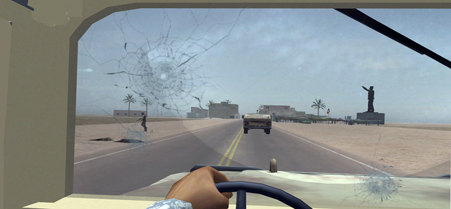Army studying use of virtual reality to treat post-traumatic stress
With more than a third of veterans from the Iraq and Afghanistan wars suffering from PTSD, the service wants to compare the new therapy with traditional methods.
 Soldiers suffering from PTSD recreate their battle experiences in a virtual world as part of their therapy at the Madigan Army Medical Center.
Soldiers suffering from PTSD recreate their battle experiences in a virtual world as part of their therapy at the Madigan Army Medical Center.
Talk to a combat veteran and you may hear tales of bad food, complaints about gear that worked poorly or not at all, and possibly gripes about poor leadership.
But many combat veterans rarely talk about the truly searing experiences of war, and that is what frequently leads to post-traumatic stress disorder, said Dr. Greg Reger, an Army psychologist with the Defense Department's National Center for Telehealth and Technology at Joint Base Lewis-McChord in Tacoma, Wash.
Instead of talking about their combat experiences, Reger said, soldiers tend to repeatedly replay an incident in heir heads, such as the explosion of an improvised explosive device that killed a friend. If a soldier does talk about his or her experience, it is with little emotion, he added.
Faced with a PTSD rate as high as 35 percent among veterans of the Iraq war, the Army has instigated a four-year study at the Madigan Army Medical Center in Tacoma to track the results of using virtual reality to treat the disorder. The PTSD project is managed by the Center for Telehealth and its parent unit, the Defense Centers of Excellence for Psychological Health and Traumatic Brain Injury.
Virtual reality offers a high-tech twist on the traditional talk therapy that psychologists believe helps soldiers deal with PTSD. Historically, doctors have used "exposure therapy," in which patients talk through their combat stress, imagining a traumatic situation and describing it to a therapist. The discussion is repeated over and over until the stress is reduced.
But Reger said just talking about a shattering combat memory often does not work with soldiers who have served multiple tours in Iraq or Afghanistan during the past nine years, with each tour adding to the stress level, the Army reported in November 2009.
Soldiers who have undergone multiple tours practice what Reger described as "adaptive emotional disengagement," in which they mentally unplug from society to survive. But traditional therapy is less effective for combat stress than it is for other traumas, such as rape, he noted.
Virtual reality exposure therapy offers a promising alternative, Reger said. During a session, the patient wears a head-mounted display and becomes immersed in a combat scenario. Reger can customize the simulation to individual experiences, recreating the weather, terrain, types of attacks and small arms fire to fit the patient's specific experience.
Using virtual reality to treat PTSD is not new. In the late 1990s, Barbara Rothbaum, a psychologist at Emory University in Atlanta, developed Virtual Vietnam , which showed positive results in a study at the Atlanta Veterans Affairs Medical Center. About 45 percent of the patients that underwent treatment using Virtual Vietnam reported a decrease in PTSD symptoms.
In 2007, the Office of Naval Research undertook its Virtual Iraq study at a few military hospitals, including the Naval Medical Center San Diego, and Tripler Army Medical Center in Honolulu , using software from Virtually Better Inc., based in Decatur, Ga. The Air Force has installed the software at eight hospitals.
Doctors in the Telehealth Center's study are using a virtual Iraq program developed by the VRPSYCH Lab at the University of Southern California's Institute for Creative Technologies. Reger said the study marks the first time virtual reality has been tested with active duty soldiers to find out how the treatment compares with traditional talk therapy.
He declined to forecast results of the study, but said virtual reality is a good way to leverage traditional therapy with technology.
According to Reger, the most effective treatment for PTSD is convincing soldiers to not avoid treatment of any kind. "Avoidance is the enemy, and we need to turn avoidance on its head," he said.
NEXT STORY: Let's Deal With Facts



